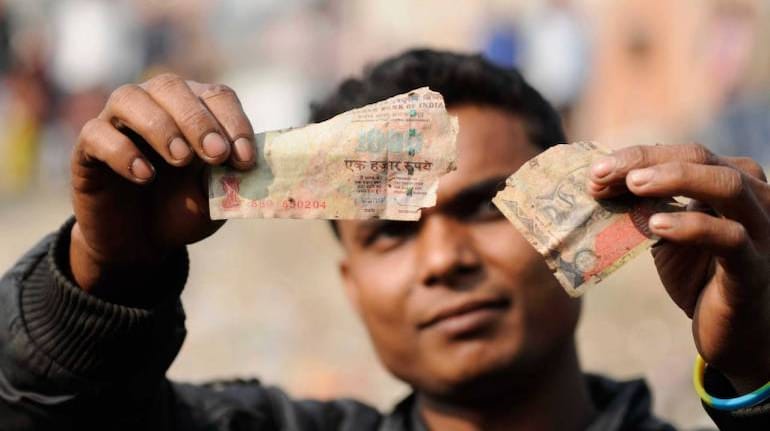



Ten months after demonetisation, the Reserve Bank of India yesterday disclosed data on cash deposits which has exposed both the dark and bright side of the note ban exercise.
While 98.96 percent of the cash withdrawn on November 8, 2016, has come back into the system, we the costs, efforts and inconvenience of citizens worth the efforts? Let us take a look.
Benefits of Demonetisation
Releasing the Annual Report on Wednesday, the Reserve Bank of India said that with the deposit of old Rs 500 and Rs 1000 notes into banks, there was a spike in households’ financial savings post demonetisation.
RBI data showed that gross financial savings rose to 11.8 percent of the gross national disposable income (GNDI) in fiscal year 2017, a jump of 90 basis points (bps) from 10.9 percent in the previous year (2015-16) and 10.1 percent in 2014-15.
Bank deposits rose by 16.2 percent as compared to 13.1 percent in the corresponding period of the previous year, reflecting a surge in deposits in the banking system.
A fallout of that has also been on the interest rates where borrowers have benefited although deposit rates also dropped. A bigger benefit was to the digital India campaign of the government where demonetisation pushed hesitant Indians to begin transacting, although there has been a decline in the volume of transactions from its peak.
Apart from more taxpayers and a bigger tax base, the number of suspicious transactions reported by banks to the Financial Intelligence Unit in FY17 has surged to 361,214 from just 61,361 in the previous year.
Notwithstanding the transitory impact of demonetisation, automobile sales accelerated, reflecting an up-tick in consumer sentiment, new launches and discount offers. Foreign tourist arrivals grew robustly, providing a boost to trade, hotels and restaurants.
Benefits at what cost
The total expenditure of the Reserve Bank increased by 107.84 percent or by Rs 16,165 crore to Rs 31,155 crore in 2016-17 primarily due to an increase in expenditure on printing of new notes as part of remonetisation of currency and provisions.
As per RBI data, the increased costs of printing the new currency was Rs 7,965 crore as against Rs 3,421 crore. This also increased provision for payables increased by Rs 684 crore to Rs 3917 crore as on June 30, 2017 due to higher provisions on outstanding expenditure for printing of notes.
Its net income also declined by 17.11 percent to Rs 43,232 crore (from Rs 52,157 crore) due to higher expenditure on managing liquidity.
Due to this, the RBI, which is India’s central bank and monetary authority, also suffered a substantial dip in its surplus transfer to the government at Rs 30,659 crore (from Rs 65,876 crore a year ago), lowest since 2011-12.
While the black money remained untouched, many small and mid-sized companies’ cash-flows went for a toss, industrial output crashed, services growth slowed and economic growth decelerated.
GDP data for the fourth quarter of 2016-17 showed that growth had slowed to 6.1 percent from over 7 percent in the previous quarter. Sectors like real estate, agriculture and finance witnessed a decline in momentum directly linked to demonetisation.
Government claims
Justifying the annual report data on Wednesday evening, Finance Minister Arun Jaitley has said, “The fallout of demonetisation is on predicted lines...the fact that money got deposited in banks doesn’t make it legitimate money.”
He said that demonetisation, coupled with GST, will give a “significant boost” to direct tax revenues as many people have come under the tax net and that the money deposited in banks means more money coming into formal channels.
Prime Minister Narendra Modi in his November 8 announcement said: “This step will strengthen the hands of the common man in the fight against corruption, black money and fake currency”. In his Independence Day speech this month he said that it will result in at least Rs 3 lakh crore not returning to system as tax evaders won’t be able to account for it.
However, either citizens weren’t hoarding enough black money (which is unlikely going by the purpose of the exercise) or the hoarders have found a way to launder it. There is also a high chance that the so-called black money would be hoarded in non-cash form like real estate and gold.
Though the exact cost-benefit analysis is yet to be made, it remains to be seen how the government lays out the long-term benefits of demonetisation in the years to come.
Discover the latest Business News, Sensex, and Nifty updates. Obtain Personal Finance insights, tax queries, and expert opinions on Moneycontrol or download the Moneycontrol App to stay updated!